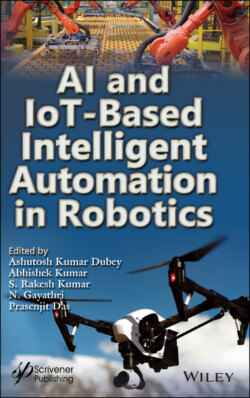Читать книгу AI and IoT-Based Intelligent Automation in Robotics - Группа авторов - Страница 13
1.1 Introduction
Оглавление“Robotics” or “robots” is a very popular term which we are increasingly hearing day by day. The word “robotics” was derived from the word “robot,” which comes from the Slavic word “robota,” meaning slave/servant. Robots were introduced to society by George C. Devol, who generally referred to them as artificial people. Generally, robots consist of different components such as sensors, controlling devices, manipulators, power supply as well as software to perform the defined action. A combination of these characteristics forms the robot. For preparing the perfect robot we have to proceed with designing, building, programming as well as testing the robot using a combination of physics, mathematics, computational techniques, mechanical engineering, electrical engineering and structural engineering. In some of the particular scenarios the concepts of biology, chemistry and medicine are also involved based on the requirements. Generally, robot technology is used [1] in environments where a human cannot perform the action.
Many people treat robots as machines but in many of the real-time applications robots replace the person and also act as a person, such as the androids in the movies Star Wars, Terminator and Star Trek: The Next Generation. The robots capture human faces and activities and perform tasks as a person does. Even though developers are implementing many advancements in robots and using them in many applications, they are not able to develop enough common sense in them because robots perform the task based on the user’s instructions but can’t predict future actions by doing tasks in a dynamic manner. So, regarding this topic, many of the researchers are working in this domain under the research domain named “humanoid robots.”
Most of the robots which were created till now are very dangerous, boring, onerous and just plain nasty. We can find these types of robots in the medical, automobile, manufacturing, and industrial industries among others, as well as the space industry. Robots, such as the Mars rover Sojourner and the upcoming Mars Exploration rover or the underwater robotic vehicle Caribou, were designed and sent to places where humans cannot go, such as volcanoes, mars, etc., for the purpose of helping to conduct research in those particular places. On the other hand, other types of robots were designed for the purpose of entertaining small children and others. A few of them are Techno, Polly and AIBO ERS-220, which often arrive at the stores around Christmas time.
Robots are very efficient, fun and easy to design. In his book Being Digital, Nicholas Negroponte relates an excellent story that took place about eight years ago at the time of the televised premier of the Media Lab’s LEGO/Logo work at the Hennigan School. When the robot was first introduced to the children in school, they didn’t show interest in adopting it. However, in a third attempt, the children talked, played and had fun with the robot. The children asked the robot questions and the robot started giving responses to the children. The children in the class felt very excited and had fun with the robot.
Finally, what exactly does robot mean?
Many authors gave definitions based on their understanding. There is really no standard definition of robotics. When designing the robot, every designer needs to have the following properties and features, if not it is not considered a robot [2].
The robot should have following characteristics:
SensingFirst, robots have to recognize the surroundings and respond according to them. The robots will not behave in all the environments. We have to imbue robots with sensitivity to light (eyes), touch, pressure (like hands), chemicals (nose), sound (ears) and taste (tongue) among others. By combining all these we will get the correct working robot for the environment.
MovementThe robot should be capable of identifying surroundings/ environment in order to perform actions such as moving its body all around the surroundings.
EnergyRobots should be capable of identifying the power in their battery and should charge by themselves.
IntelligenceRobots need to become smarter than humans. Those who make robots smart are called programmers. Robots should require a minimum amount of knowledge to understand and perform the task that the user instructed.
So, the definition of the term robot encompasses a sensor, controlling device, physical device, manipulator, and a programming testing device, with mechanical engineering, electrical engineering, mathematics, and a small portion of chemistry also being involved.
